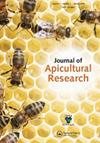The association between the hypopharyngeal glands and the molecular mechanism which honey bees secrete royal jelly
IF 1.8
4区 农林科学
Q2 ENTOMOLOGY
引用次数: 0
Abstract
AbstractRoyal jelly (RJ), a substance secreted by the hypopharyngeal and mandibular glands of nurse worker bees, is widely used in medical products, dietary supplements, health foods, and cosmetics, owing to its potential health benefits. An understanding of secretory glands, such as the hypopharyngeal glands (HGs), and their interactions are necessary for RJ secretion. The RJ production cycle should be expanded for more effective production, which requires additional experience and training. However, the association between RJ secretion and HGs levels remains unclear. To close this gap, we conducted this review to investigate the most recent advancements in HGs and RJ secretion in Apis mellifera. These include techniques for enhancing RJ production, the morphology of HGs, RJ biological and effectiveness in the treatment of diseases, a comparison of the secretion of RJ signaling pathways in honey bees, associated genes, the proteins of HGs, and elements that could affect the secretion of HGs and the mechanism of RJ secretion. In order to help bee products strategy, our review may be valuable for a better understanding of the association between HGs and RJ secretion.The heads of bees have secretory glands, especially hypopharyngeal glands (HGs), and mandibular glands located in front of the worker bees head, which secretes through the mouthparts with three main functions: Saliva to mix with food, larval feeding secretion, chemicals to communicate with other bees, and anesthetic chemicals. HGs: Contain royal jelly (RJ) protein in nurse bees; however, invertase in foragers. Often changes function with age, in the young bee’s lipids for RJ; old bees alarm pheromone 2-haptanone, and Isopentylic acetate.Keywords: Apis melliferahypopharyngeal glandsroyal jellyproductionsecretion AcknowledgmentsWe are grateful to Mr. Richard Weir for his constructive comments during the preparation.Disclosure statementNo potential conflict of interest was reported by the authors.Additional informationFundingThis work was supported by the National Natural Science Foundation of China [No. 31772684], the China Agriculture Research System of MOF, and MARA [No. CARS-44-KXJ4].下咽腺与蜜蜂分泌蜂王浆分子机制的关系
蜂王浆(RJ)是一种由护理工蜂下咽和下颌腺分泌的物质,由于其潜在的健康益处,被广泛应用于医疗产品、膳食补充剂、保健食品和化妆品中。了解下咽腺(HGs)等分泌腺及其相互作用是RJ分泌的必要条件。应扩大RJ生产周期,以便更有效地生产,这需要更多的经验和培训。然而,RJ分泌与HGs水平之间的关系尚不清楚。为了缩小这一差距,我们对蜜蜂中HGs和RJ分泌的最新进展进行了综述。其中包括提高RJ生产的技术、RJ的形态、RJ的生物学和治疗疾病的有效性、蜜蜂中RJ信号通路分泌的比较、相关基因、RJ的蛋白质、可能影响RJ分泌的元素和RJ分泌的机制。为了帮助蜜蜂产品策略,我们的综述可能对更好地理解HGs和RJ分泌之间的关系有价值。蜜蜂的头部有分泌腺,尤其是下咽腺(HGs)和位于工蜂头部前方的下颌腺,它通过口器分泌,主要有三种功能:与食物混合的唾液、幼虫取食的分泌物、与其他蜜蜂交流的化学物质和麻醉化学物质。HGs:含有蜂王浆蛋白(RJ);然而,在觅食动物中。常随年龄变化功能,在年轻蜜蜂的脂质为RJ;老蜜蜂报警信息素2-半胱甘肽和醋酸异戊酯。感谢Richard Weir先生在编写过程中提出的建设性意见。披露声明作者未报告潜在的利益冲突。附加信息:基金资助:国家自然科学基金[No. 1];[31772684],中国农业部农业研究系统;CARS-44-KXJ4]。
本文章由计算机程序翻译,如有差异,请以英文原文为准。
求助全文
约1分钟内获得全文
求助全文
来源期刊
CiteScore
4.80
自引率
10.50%
发文量
111
审稿时长
6-12 weeks
期刊介绍:
The Journal of Apicultural Research is a refereed scientific journal dedicated to bringing the best research on bees. The Journal of Apicultural Research publishes original research articles, original theoretical papers, notes, comments and authoritative reviews on scientific aspects of the biology, ecology, natural history, conservation and culture of all types of bee (superfamily Apoidea).

 求助内容:
求助内容: 应助结果提醒方式:
应助结果提醒方式:


